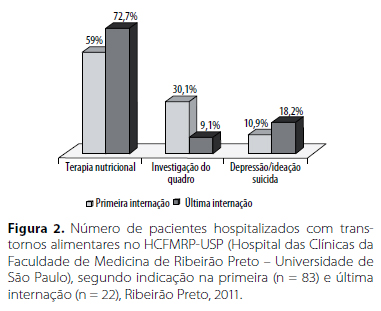OBJECTIVE: To describe the characteristics of inpatient treatment for eating disorders in a specialized service in Ribeirao Preto, SP. METHODS: We reviewed all the medical records of patients followed up for the service between 1982 and 2011, particularly those who received inpatient treatment. Sociodemographic data and related to diagnosis were collected. RESULTS: In the said period, 186 patients were treated by the service and 44.6% (n = 83) were hospitalized for treatment. A reduction was observed in hospitalization rates of 77,7% to 36,2% over time. The average hospitalization was 1.9 ± 3.9 times of which 73.5% (n = 61) patients were hospitalized only once. The mean duration of hospitalization, regardless of the number of hospitalizations was 70.6 ± 115.9 days (range 3-804 days). Most patients were female, Caucasian, unmarried, childless and with a mean age of 23.3 ± 10.8 years old. The predominant diagnosis was anorexia nervosa (85.5%), especially in its restrictive type (54.2%). The most common indications for hospitalization were for nutritional support therapy (50.9%), followed by the clinical research (30.1%) and due to depression or suicidal ideation (10.9%). CONCLUSION: Inpatient treatment was a therapeutic modality required for treatment of these patients and their frequency was significant, but decreased over time. This result can be explained by the trend of deinstitutionalization from the psychiatric reform, earlier diagnosis and treatment and the experience gained by service professionals over the years.
Eating disorders; inpatient treatment; anorexia nervosa; bulimia nervosa




